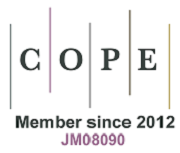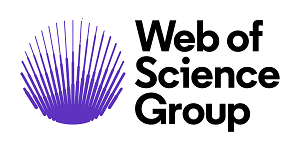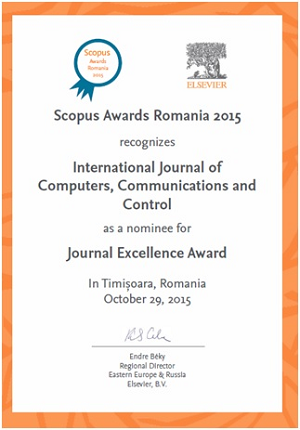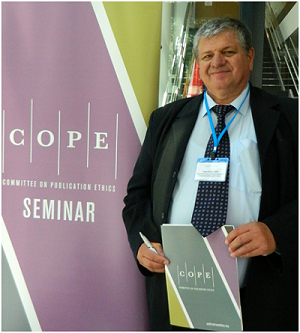Hierarchical Decision-making using a New Mathematical Model based on the Best-worst Method
Keywords:
decision model, MCDM, best-worst method, hierarchical decisionmaking, pairwise comparisonAbstract
Decision-making processes in different organizations often have a hierarchical and multilevel structure with various criteria and sub-criteria. The application of hierarchical decision-making has been increased in recent years in many different areas. Researchers have used different hierarchical decision-making methods through mathematical modeling. The best-worst method (BWM) is a multi-criteria evaluation methodology based on pairwise comparisons. In this paper, we introduce a new hierarchical BWM (HBWM) which consists of seven steps. In this new approach, the weights of the criteria and sub-criteria are obtained by using a novel integrated mathematical model. To analyze the proposed model, two numerical examples are provided. To show the performance of the introduced approach, a comparison is also made between the results of the HBWM and BWM methodologies. The analysis demonstrates that HBWM can effectively determine the weights of criteria and sub-criteria through an integrated model.References
Aboutorab, H., Saberi, M., Asadabadi, M.R., Hussain, O.,Chang, E. (2018). ZBWM: The Z-number extension of Best Worst Method and its application for supplier development, Expert Systems with Applications, 107, 115-125, 2018. https://doi.org/10.1016/j.eswa.2018.04.015
Badi, I.; Ballem, M. (2018). Supplier selection using the rough BWM-MAIRCA model: A case study in pharmaceutical supplying in Libya, Decision Making: Applications in Management and Engineering, 1(2), 16-33, 2018. https://doi.org/10.31181/dmame1802016b
Baky, I.A. (2014). Interactive TOPSIS algorithms for solving multi-level non-linear multiobjective decision-making problems, Applied Mathematical Modelling, 38(4), 1417-1433, 2014. https://doi.org/10.1016/j.apm.2013.08.016
Ecer, F. (2018). Third-party logistics (3PLs) provider selection via Fuzzy AHP and EDAS integrated model, Technological and Economic Development of Economy, 24(2), 615-634, 2018. https://doi.org/10.3846/20294913.2016.1213207
Farias, L.M.S.; Santos, L.C.; Gohr, C.F.; Rocha, L.O. (2019). An ANP-based approach for lean and green performance assessment, Resources, Conservation and Recycling, 143, 77-89, 2019. https://doi.org/10.1016/j.resconrec.2018.12.004
Guo, S.; Zhao, H. (2017). Fuzzy best-worst multi-criteria decision-making method and its applications, Knowledge-Based Systems, 121, 23-31, 2017. https://doi.org/10.1016/j.knosys.2017.01.010
Gupta, H.; Barua, M.K. (2016). Identifying enablers of technological innovation for Indian MSMEs using best-worst multi criteria decision making method, Technological Forecasting and Social Change, 107, 69-79, 2016. https://doi.org/10.1016/j.techfore.2016.03.028
Gupta, H.; Barua, M.K. (2017). Supplier selection among SMEs on the basis of their green innovation ability using BWM and fuzzy TOPSIS, Journal of Cleaner Production, 152, 242- 258, 2017. https://doi.org/10.1016/j.jclepro.2017.03.125
Gupta, P.; Anand, S.; Gupta, H. (2017). Developing a roadmap to overcome barriers to energy efficiency in buildings using best worst method, Sustainable Cities and Society, 31, 244-259, 2017. https://doi.org/10.1016/j.scs.2017.02.005
Hafezalkotob, A.; Hafezalkotob, A. (2017). A novel approach for combination of individual and group decisions based on fuzzy best-worst method, Applied Soft Computing, 59, 316-325, 2017. https://doi.org/10.1016/j.asoc.2017.05.036
Ilieva, G.; Yankova, T.; Klisarova-Belcheva, S. (2018). Decision analysis with classic and fuzzy EDAS modifications, Computational and Applied Mathematics, 37(5), 5650-5680, 2017. https://doi.org/10.1007/s40314-018-0652-0
Jiang, W.; Huang, C. (2018). A multi-criteria decision-making model for evaluating suppliers in green SCM, International Journal of Computers Communications & Control, 13(3), 337- 352, 2018. https://doi.org/10.15837/ijccc.2018.3.3283
Khan, M.S.A. (2019). The Pythagorean fuzzy Einstein Choquet integral operators and their application in group decision making, Computational and Applied Mathematics, 38(3), 128, 2019. https://doi.org/10.1007/s40314-019-0871-z
Khanmohammadi, E.; Zandieh, M. (2018). Drawing a Strategy Canvas Using the Fuzzy Best-Worst Method, Global Journal of Flexible Systems Management, 20(1), 57-75, 2018. https://doi.org/10.1007/s40171-018-0202-z
Lei, L.; Zhang, W.F. (2013). Extended VIKOR method for multi-level hybrid multi-attribute group decision making, 25th Chinese Control & Decision Conference(CCDC), 1718-1722, 2013. https://doi.org/10.1109/CCDC.2013.6561209
Lu, J.; Han, J.; Hu, Y.; Zhang, G. (2016). Multilevel decision-making: A survey, Information Sciences, 346, 463-487, 2016. https://doi.org/10.1016/j.ins.2016.01.084
Maghsoodi, A.I.; Mosavat, M.; Hafezalkotob, A.; Hafezalkotob, A. (2019). Hybrid hierarchical fuzzy group decision-making based on information axioms and BWM: Prototype design selection, Computers & Industrial Engineering, 127, 788-804, 2019. https://doi.org/10.1016/j.cie.2018.11.018
Mardani, A.; Jusoh, A.; Nor, K.; Khalifah, Z.; Zakwan, N.; Valipour, A. (2015). Multiple criteria decision-making techniques and their applications-a review of the literature from 2000 to 2014., Economic Research-Ekonomska IstraLživanja, 28(1), 516-571, 2015. https://doi.org/10.1080/1331677X.2015.1075139
Mardani, A.; Jusoh, A.; Zavadskas, E.K. (2015). Fuzzy multiple criteria decision-making techniques and applications-Two decades review from 1994 to 2014, Expert Systems with Applications, 42(8), 4126-4148, 2015. https://doi.org/10.1016/j.eswa.2015.01.003
Mou, Q.; Xu, Z.; Liao, H. (2016). An intuitionistic fuzzy multiplicative best-worst method for multi-criteria group decision making, Information Sciences, 374, 224-239, 2016. https://doi.org/10.1016/j.ins.2016.08.074
Naz, S.; Akram, M. (2019). Novel decision-making approach based on hesitant fuzzy sets and graph theory, Computational and Applied Mathematics, 38(1), 7, 2019. https://doi.org/10.1007/s40314-019-0773-0
Pamucar, D.; Chatterjee, K.; Zavadskas, E.K. (2019). Assessment of third-party logistics provider using multi-criteria decision-making approach based on interval rough numbers, Computers & Industrial Engineering, 127, 383-407, 2019. https://doi.org/10.1016/j.cie.2018.10.023
Patriarca, R.; Di Gravio, G.; Costantino, F.; Falegnami, A.; Bilotta, F. (2018). An Analytic Framework to Assess Organizational Resilience, Safety and Health at Work, 9(3), 265-276, 2018. https://doi.org/10.1016/j.shaw.2017.10.005
Ren, H.; Liu, M.; Zhou, H. (2019). Extended TODIM method for MADM problem under trapezoidal intuitionistic fuzzy environment, International Journal of Computers Communications & Control, 14(2), 220-232, 2019. https://doi.org/10.15837/ijccc.2019.2.3428
Ren, J.; Liang, H.; Chan, F.T.S. (2017). Urban sewage sludge, sustainability, and transition for Eco-City: Multi-criteria sustainability assessment of technologies based on best-worst method, Technological Forecasting and Social Change, 116, 29-39, 2017. https://doi.org/10.1016/j.techfore.2016.10.070
Rezaei, J. (2015). Best-worst multi-criteria decision-making method, Omega, 53, 49-57, 2015. https://doi.org/10.1016/j.omega.2014.11.009
Rezaei, J. (2016). Best-worst multi-criteria decision-making method: Some properties and a linear model, Omega, 64, 126-130, 2016. https://doi.org/10.1016/j.omega.2015.12.001
Rezaei, J.; Wang, J.; Tavasszy, L. (2015). Linking supplier development to supplier segmentation using Best-Worst Method, Expert Systems with Applications, 42(23), 9152-9164, 2015. https://doi.org/10.1016/j.eswa.2015.07.073
Saaty, T.L. (1977). A scaling method for priorities in hierarchical structure, Journal of Mathematical Psychology, 15(3), 234-281, 1997. https://doi.org/10.1016/0022-2496(77)90033-5
Saaty, T.L. (1990). How to make a decision: the analytic hierarchy process, European Journal of Operational Research, 48(1), 9-26, 1990. https://doi.org/10.1016/0377-2217(90)90057-I
Saaty, T.L.; Takizawa, M. (1986). Dependence and independence: From linear hierarchies to nonlinear networks, European Journal of Operational Research, 26(2), 229-237, 1986. https://doi.org/10.1016/0377-2217(86)90184-0
Safarzadeh, S.; Khansefid, S.; Rasti-barzoki, M. (2018). A group multi-criteria decisionmaking based on best-worst method, Computers & Industrial Engineering, 126, 111-121, 2018. https://doi.org/10.1016/j.cie.2018.09.011
Salimi, N., Rezaei, J. (2016). Measuring efficiency of university-industry Ph. D. projects using best worst method, Scientometrics, 109(3), 1-28, 2016. https://doi.org/10.1007/s11192-016-2121-0
Serrai, W.; Abdelli, A.; Mokdad, L.; Hammal, Y. (2017). Towards an efficient and a more accurate web service selection using MCDM methods, Journal of Computational Science, 22, 253-267, 2017. https://doi.org/10.1016/j.jocs.2017.05.024
Sharaf, I.M. (2018). TOPSIS with similarity measure for MADM applied to network selection, Computational and Applied Mathematics, 37(4), 4104-4121, 2018. https://doi.org/10.1007/s40314-017-0556-4
Sitorus, F.; Cilliers, J.J.; Brito-Parada, P.R. (2018). Multi-Criteria Decision Making for the Choice Problem in Mining and Mineral Processing: Applications and Trends, Expert Systems with Applications, 121, 393-417, 2018. https://doi.org/10.1016/j.eswa.2018.12.001
Tabatabaei, M.H.; Amiri, M.; Khatami Firouzabadi, S.M.A.; Ghahremanloo, M.; Keshavarz-Ghorabaee, M.; Saparauskas, J. (2019). A new group decision-making model based on bwm and its application to managerial problems, Transformations in Business and Economics, 18(2), 197-214, 2019.
Triantaphyllou, E.; Mann, S.H. (1995). Using the Analytic Hierarchy Process for Decision Making in Engineering Applications: Some Challenges, International Journal of Industrial Engineering: Applications and Practic, 2(1), 35-44, 1995.
Van De Kaa, G.; Scholten, D.; Rezaei, J.; Milchram, C. (2017). The battle between battery and fuel cell powered electric vehicles: A BWM approach, Energies, 10(11), 1707, 2017. https://doi.org/10.3390/en10111707
Wei, G.; Wang, J. (2017). A comparative study of robust efficiency analysis and Data Envelopment Analysis with imprecise data, Expert Systems with Applications, 81, 28-38, 2017. https://doi.org/10.1016/j.eswa.2017.03.043
Xu, G.; Wang, S.; Yang, T.; Jiang, W. (2018). A neutrosophic approach based on TOPSIS method to image segmentation, International Journal of Computers Communications & Control, 13(6), 1047-1061, 2018. https://doi.org/10.15837/ijccc.2018.6.3268
You, P.; Guo, S.; Zhao, H.; Zhao, H. (2017). Operation performance evaluation of power grid enterprise using a hybrid BWM-TOPSIS method, Sustainability, 9(12), 2329, 2017. https://doi.org/10.3390/su9122329
Zak, J.; Kruszynski, M. (2015). Application of AHP and ELECTRE III/IV methods to multiple level, multiple criteria evaluation of urban transportation projects, Transportation Research Procedia, 10, 820-830, 2015. https://doi.org/10.1016/j.trpro.2015.09.035
Zhao, H.; Guo, S.; Zhao, H. (2018). Comprehensive performance assessment on various battery energy storage systems, Energies, 11(10), 2841, 2018. https://doi.org/10.3390/en11102841
Zhao, H.; Zhao, H.; Guo, S. (2018). Comprehensive Performance Evaluation of Electricity Grid Corporations Employing a Novel MCDM Model, Sustainability, 10(7), 2130, 2018. https://doi.org/10.3390/su10072130
Published
Issue
Section
License
ONLINE OPEN ACCES: Acces to full text of each article and each issue are allowed for free in respect of Attribution-NonCommercial 4.0 International (CC BY-NC 4.0.
You are free to:
-Share: copy and redistribute the material in any medium or format;
-Adapt: remix, transform, and build upon the material.
The licensor cannot revoke these freedoms as long as you follow the license terms.
DISCLAIMER: The author(s) of each article appearing in International Journal of Computers Communications & Control is/are solely responsible for the content thereof; the publication of an article shall not constitute or be deemed to constitute any representation by the Editors or Agora University Press that the data presented therein are original, correct or sufficient to support the conclusions reached or that the experiment design or methodology is adequate.







